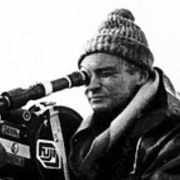
Paul Leach
In between spells as a journalist, director and draughtsman, the late Paul Leach spent much of his screen career as a camera operator — a role that provides a formidable test of creativity and fortitude.
After work in newspapers and time as a cameraman in Canada, Leach moved into feature films in the second half of the 1970s, just as the Kiwi movie renaissance was taking flight. In his book Shot in New Zealand, author Duncan Petrie argues that during that first decade of feature production, Leach became the country's camera operator of choice.
Leach's first forays into the media world involved working as a journalist at the New Zealand Herald. There he met fellow film enthusiast Mike Nicolaidi. The two collaborated on super-8 short Pas De Deux (1959), and spent time in Canada, where their work included short film Castaway. Ironically director Nicolaidi would later end up writing for showbusiness magazine Variety, reviewing a number of the iconic movies Leach worked on.
Leach remained in Canada for most of the 60s, working as a cameraman at the country's highly respected National Film Board. The board's output was diverse, and Leach filmed everything from Expo 67 to portraits of working class poverty. Experimental film 23 Skidoo, which features chilling scenes of urban streets stripped of people, was nominated for a BAFTA award.
Leach won a Canadian Donald C Mulholland Award for his black and white cinematography for 1964 teen pregnancy tale Phoebe, directed by Hungarian emigre George Kaczender. Five years later Leach was invited to take on cinematography duties on Kaczender's first feature, family drama Don't Let the Angels Fall. The film would become the first Canadian feature invited to compete at Cannes. Leach also shared a 1970 Canadian Film Award for his black and white cinematography on solo mother short Mrs Case.
When Leach returned down under in 1970, he began working in the newsroom at the NZ Broadcasting Corporation, helping compile the nightly news bulletin. In 1974 he took time off to shoot children's serial The Games Affair, partly shot during the Commonwealth Games. This independently-made drama brought him into contact with many future collaborators, including cinematographers Alun Bollinger, Graeme Cowley, Leon Narbey and Kevin Hayward.
Soon after, Leach joined the team of directors on weekly documentary TV series Encounter, and shot some commercials for director Roger Donaldson. When Donaldson told him he wanted to make a feature film, Leach quit his job in broadcasting to join in. That movie was Sleeping Dogs ,the movie often cited as kickstarting the Kiwi film renaissance. Leach was camera operator, a position which traditionally reports to the director of photography (in this case ex-Pacific Films cinematographer Michael Seresin).
Following Sleeping Dogs, Leach aimed his camera at a Raetihi massage parlour (Skin Deep), Pākeha teachers in denial (Middle Age Spread) and culturally-dislocated Samoans (Sons for the Return Home, shot partly in Western Samoa).
In 1981 Leach reteamed with director Roger Donaldson for Donaldson's second feature, the beautifully-lensed Smash Palace. This portrait of a marriage in meltdown also marked the first of many times that Leach would team up with director of photography Graeme Cowley. They collaborated again on Geoff Murphy's technically-demanding epic Utu, yokels-in-the-city comedy Carry Me Back, and Merata Mita's debut drama Mauri.
In Duncan Petrie's book Shot in New Zealand, Cowley paid tribute to Leach's skills, and understanding of story. "He had a fantastic and very concise way of placement of the camera — what's in the frame and what the frame is saying ... he was clear and concise and a logical force at the centre of the production, and often directors were not as experienced in those finer points. Paul kept all those productions together — in many ways he was the unifying cameraperson, the director of pictures for New Zealand."
Leach is remembered by many for his calmness and helpful temperament, which made the stress of a film set an easier place to be.
After shooting the classic Came a Hot Friday (1984, director of photography Alun Bollinger) Leach found himself working with DoP Kevin Hayward, who Leach had first dragged behind a camera from the darkness of an editing suite, a decade before. The movie was 50s set melodrama Constance, the film which ought to have made a movie star of Donogh Rees. Leach made a number of important contributions to the film's look, including suggesting the use of wide-angle lenses.
He was also behind the camera for the film's ambitious final scene, in which the camera appears to float out of a house. This single shot took three days to prepare and pull-off; Hayward later recalled that it necessitated input from nearly every grip then working in New Zealand.
The following year Leach worked on acclaimed last man on earth tale The Quiet Earth, his second feature for director Geoff Murphy. Working with director of photography James Bartle, Leach brought to the table his experiences two decades earlier of having recreated another deserted city, for 23 Skidoo. The Quiet Earth won a GOFTA award for best cinematography in 1987.
Leach later concentrated on a new career as an architectural draughtsman.
Paul Leach passed away on 10 April 2010. He is fondly remembered by many in the film industry who have worked beside him.
Sources include
Duncan Petrie, Shot in New Zealand - The art and craft of the Kiwi cinematographer (Auckland:Random House, 2007)
The Making of Sleeping Dogs (Documentary) Director John Reid